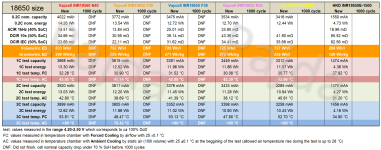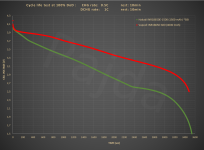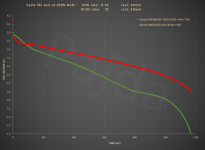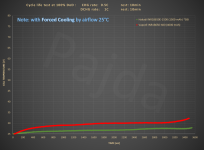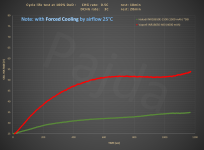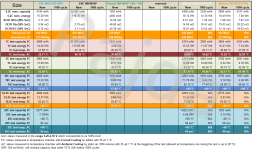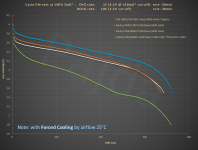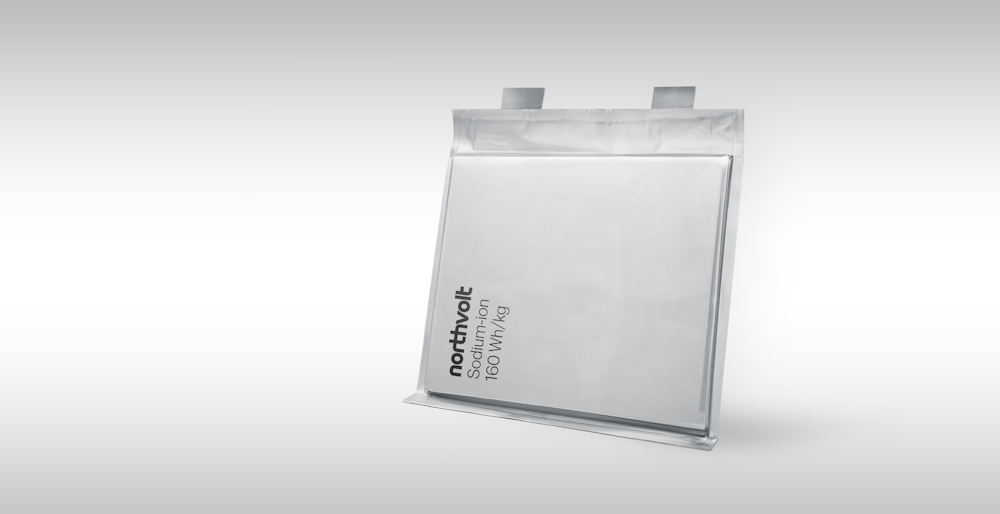My first round test with Sodium ion batteried (NA-26700-3500) My particular process is not a vehicular one.
It is a long and detailed story, but the short form. Small portable power station should be considered a viable product if it meets the following spec:
Less than 22 pounds (no idea where that came from, but gotchya)
can independently withstand a 24" drop and maintain safety (as in, no release of the magic smoke)
Provide sufficient power to run a light (bunch of specs, unimportant, very bright LED will do the job, I mount 2 forward facing and a cob cluster or strip on the side for a non-directional diffuse light source)
Needs to be able to be charged from vehicles (12/24v) and standard mains circuit.
Needs "sufficient" power to run over-night (no info on load, later found they want 12 hours of 2 leds not a problem)
They later put in some stuff for these 3x4 throw blankets that have usb heaters (runs on standard 2a usb, again, not a problem)
The units I produce are in either a standard military ammo box (cal .30 usually, although I have a few cal.50 boxes around for testing)
Included in the unit are the lights mentioned above, an emergency broadcast unit for medical emergencies, not fully released yet because there are some questions about having a medical alert hot button without any registration req) 2 x 2 port USB surface mounted. top handle (standard) side "buddy carry" handles extendable from interior, short USB cable (multi-tip) and a flip out cloth pocket suitable to hold a cel phone or tablet while it is charged (it is rough 8x8" it held all my devices and I found a source) additional other items include compressed towels, a small boo boo kit, and an emergency blanket (the one I use I tracked down by corner connecting the unit to 4 poles then it had to take my body weight in full battle rattle, so I dropped 346 pounds on it. I ate a lot of dirt but finally found one that held up. One goes in with the boo boo buddy)
I have handed these bad boys out a to a lot of people. A local non/religious but oddly ran by a church org will happily buy as many as I can make within reasonable rates (the only variable is of course batteries)
So, I built one out using mostly my standard kit, had a bit of a pause while I tracked down a BMS (remember, has to match up to the charger kit) and then make sure that it would cooperate with my buck/boost unit I install (set to a fixed rate which I have to juggle occasionally with dif cel chemistry)
I have these in cycle with some folks that are volunteers for S&R in the Sierra Nevada's couple police officers, a pair of hard core wild outdoorsy types that have made it their mission to come up with a solar solution that will strap to the side and of course a bunch of homeless people (no, they are not experiencing it, they are suffering through it I refuse to muddy my speech)
So the unit I built for this test included 8 cels (4s2p) giving nominal 12v connectivity. I set the battery charger unit to run at 16v flat, the stats sheet showed an expected 4.1v/cel and the unit in this test case was a 2a, should be fine and in fact has caused no issues.
I have seen numerous people doing bench testing. I am neither as well set up for that, nor as knowledgeable. However I do have a rather unique set of skills when it comes to questionable kit built by the lowest bidder and chosen by people who have only seen the great outdoors through some form of clear material as they flew/drove by it. I think it rather fitting I am now the builder for such a group. (the Christian group that I am providing these for are truly lovely people, but one of them told me that they had spent 4 years in the Scouts so we had that in common.. I decided to just agree and overlook that they generally don't get shot at much)
So this unit has spent 3 very long wet days with one of the homeless guys I know. He was worried about "the Salt never caused any problems, I picked the lock you have keeping the electrics in the bottom of the box, you need a better lock, I kept checking it to make sure no salt was leaking out" He is a wonderful guy, and I am now looking into a better lock (The top of the box is openable for the cable/booboo buddy etc storage, batts and wiring is secured underneath the barrier)
in the long wet weekend I was informed of a few things:
7Ah is not nearly as good as the normal 20Ah units I normally produce. this was a limitation caused by the box I use in this kit will only fit 8 cels and I was too cheap to buy the higher capacity ones. All 4 people that took these out had the same comment, and were happy it was a spare unit, not their normal one.
It does not have the "kick" with the heater that the regular ones use (I am still trying to figure out what is the cause of this. it is running same volts, same amps etc.. Might be output curve.. I need to run a test with a logging system to see if there is some issue with how I laid in the buck/boost.
Firemen response: "it was great, crapped out on like the 5th cel phone, I like that it weighs less. And you know if you use a 5 amp charger it charges faster" unit has been put into a group of tests to see if they cooked anything. Frigging firemen..
Hikers: You know, I would love to have one of the ligher ones that had the same power. discussion led me to find out, they have a foldable solar system that is max 30w (I am waiting for model info) and it was all the charger they had on the weekends outing. I don't know that it got a complete charge, and it only evidently ran lights for about 4 hours on day 2... Still need to figure out what all happened, I request that people fill out a log when lugging my test boxes, some are better than others.
Yes, this is *not* a vehicle test, however these things get the abuse that only people carrying heavy things can dish out. I have gotten a box back where the top/bottom were a bit scratched up, and the sides were nearly 2cm shorter than they had been. Evidently you can in fact hold up a ford focus with one, but not a bronco.
Biggest drop survived was 8 vertical feet with only a slightly popped hinge it fell out of a backpack while someone was climbing out of a gully.
Longest bouncy roll: 40-60 feet down, and that is about 30 feet out.. Fell out of a bike rack and down the hill. Fully popped hinge, weld spots on latching handle torn, all the small bits were ejected, battery/electrics were mostly intact, one of the USB units was never found (and I am at a complete loss at how that round bastard got away, i have switched up the build, so it is inserteded into a drilled hole. Affixed with the threads that it comes with and a metal nut that is made locally for me. It is 1/4 inch steel with wider flanges and then threaded to match the units. I had gone with these units becasue they are cheap, and I have installed them in vehicles and they did well. The first units popped out, usually a thread failure. I added in some doping the edges with epoxy and Silica spooge (not at the same time) turns out, Silicon is cheaper, and easier to work with and performs the same. I am adding a pair of lugs on the side of the driller hole and adding a strap to the system. I do not want these things coming apart.
And best recovery by the lovely lads at CHP it was lost during a hitch-hiking event, and found by San Diego a couple weeks later. They shipped it back to me and I have to say, Vietnam Era .50 cal boxes are stupid rugged. This thing hit everything but the lottery. Battery pack was intact, all the surface mounts were either completely gone, or ground to a thread.
I am still mucking about with the stowage in the bottom. So far best luck has been my plastic battery box with internal supports, and some thing sticky foam (same stuff they make wetsuits out of with some 3m canned adhesive on the back) on the outside, another layer of foam, and then a semi-rigid paper (barley paper) and either wrapped in various versions of scuff tape/riggers tape shrink wrap.. I think I have a couple I ended up finishing with Duck tape (that is not a typo) because I was out of everything else...
The next test run is awaiting additional bits. Specifically the firemen have hit me up for a less "helpful stuff" more ah unit. They have put funds forward to pay for the cels.
I have the following items in route now:
32140 4.1v cels 3s4p (ordered enough to make that a 4s if necessary, the specs are hinky showing them as 4.2v and 3v in various places better safe than sorry ) these units are also a new product, and they are showing at 10000mAh and showing at 270g/each so this is gonna be a fairly heavy unit. I was informed that they train enough to carry my fat ass up 6 flights of stairs, they can handle putting a battery on the rig I am estimating the final unit weight at 5-10Kg WIll report when I get the units. This should give us a walloping 40Ahin a fairly tight package (using the .30cal boxes, I might use one of the more modern 5.52 units but Not sure I can get these as cheap)
I have a new BMS coming it is nicer than the last one and came with something that resembled a manual, and diagram. It even has words on it that I can read.
a second set of test cels same formula; 21600 3v 18Ah... ::blinks::
I am putting them in a 4s5p at the request of the guys paying for it this in theory should bang out at 90Ah... I have no idea what I am gonna charge this with.. going to have to be more aggressive or set it up to use multiple chargers because that is a LOT more juice that I am used to pouring into batteries.
I am using a bottom only platic matric on the current sodium cels. I somehow managed to deform the ones I hordered and I am not happy with my home-printed units yet, still getting used to the new 3d printer.
For 21700 I am ordering a top/bottom matrix set for them, and I do square set, not the tighter inter-set ones. I have these in a box with a thermal trigger to open up a vent unit, and I thus far have never needed to add a circulation fan and if I do it will be an issues for the water resistance level I like to have.
Will do the same basic tests, and hopefully the new circuit I have being built that actually logs things will add a couple items.
1) GPS tracking so I know where it has been (just logging, I have legal stuff to go through to make sure everyone is ok with this) I would like to be able to reference when/where it broke.
2) full activity logging
3) I am working with the emergency cellular service group they and the firemen would like me to set up a portable cellular relay booster . I have not gotten the spec on the unit yet, I don't see a reason not to do so.
4) and the coolest part. It is getting a short hatchet and some metal contraption so they can pound it into things and hang the unit up to give some height to the relay.. I am looking forward to watching people hack a shelf into a building.
I am also talking to a sparky about putting together a better solution for using a modular battery than what I have now. Not sure if I want to stick with the same boxes or go another route for these. The big findings from what I have seen is that the log on the thermal probe shows that even when these units were firing all the lights, and the cel charger, and the heating blanky.. they didn't heat up nearly as much as I was expecting. Not sure if that is to be expected, or only to be expected when it is pouring rain and the unit is setting on soaked soil.
